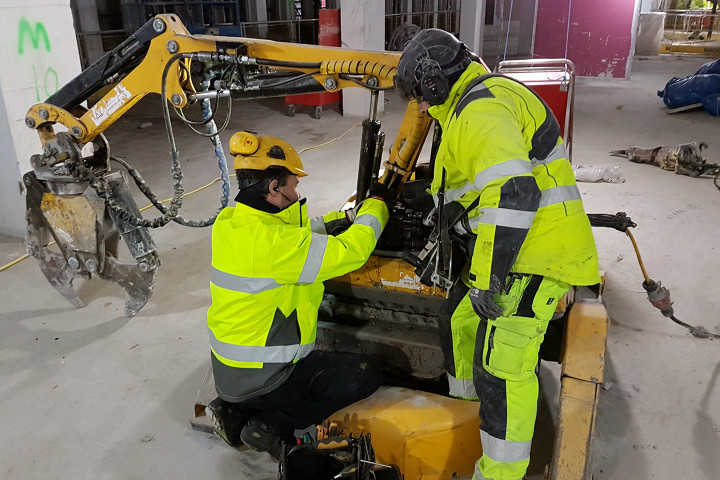End of Shift Upkeep

14 July 2021 News articles
No matter how tired you are at the end of the day, a true pro knows you never leave the jobsite without putting away your tools. It’s the same for a wrench as it is for a Brokk demolition robot. Before calling it quits for the day — or decommissioning from the jobsite at the end of the project — there are several important steps to follow to make sure your Brokk robot is ready for the next day and the next job.
End of Day
Demolition is a dusty job. Thanks to Brokk’s remote operation your crew won’t be totally covered with concrete dust, but at the end of an 8-10-hour day, your robot will be. End-of-day procedures should start with a quick dusting. Don’t worry about getting in every nook and cranny for the moment but try to clear away the surface layer of dust. Concrete dust hardens when exposed to moisture, like dew or condensation that can form overnight, so removing it quickly is key to keeping your Brokk robot operational.
As you prepare to store your equipment, take the opportunity to give the equipment a quick once over. If you’ve put eight or more hours on the machine, be sure to grease the tool mounting and arm system. Inspect hoses for any water damage or leaks. Make sure electric cables are disconnected and look them over for crimps, nicks or other damage. Additionally, check fluid levels for hydraulics and breaker lubricant. For diesel machines, be sure to check oil and coolant levels, as well. The manual will walk you through the specifics for your machine.
Where you park overnight is also important – or rather how you park. You always want it in a transportable position in case you need to pick it up with a forklift. At the end of the day, be sure your machine is parked in an easily accessible position with the boom tucked in.
End of the Project
Once you’re back at the shop, it’s time for a more thorough cleaning. Wash the robot with a pressure washer, taking care to avoid electrical components. Be sure to wash in crevices to remove all dust and debris. Dry using compressed air since allowing the unit to dry naturally or using a towel could allow any residual dust to harden. Finally, lubricate all components. This helps push out any water that might have made it into the bushing joints.
Again, check the manual for any routine maintenance based on your machine’s hours of operation. Take time to thoroughly inspect the machine and make necessary repairs or replacements, as well.
Storage
Keeping your Brokk busy shouldn’t be a challenge with our extensive range of attachments that let you tackle a number of applications, but when you need to store your robot between jobs, again, be sure to park it in an easily accessible position.
Brokk robots are designed to withstand some of the harshest conditions around, but proper storage is still important for long-term dependability. A temperature-controlled environment is ideal but not always realistic. The main concern is keeping your equipment as dry as possible to avoid any malfunctions, so if you must keep your Brokk outside, make sure it’s covered.
Additionally, the breaker and remote have special storage instructions. These elements should be stored indoors. For the breaker, be sure to store in the vertical position to keep seals from deforming. The remote should also be wiped down before storage and the batteries removed.
The Next Job
Whether your Brokk robot has been sitting for a day or a week, run through the cycles of each function to be sure everything is in working order before loading up for the next job. For parts or service questions, our team is available at 1-800-621-7856.
Stay updated!
Thank You!
Thanks for your message. We’ll answer as soon as possible!
// The Brokk team
